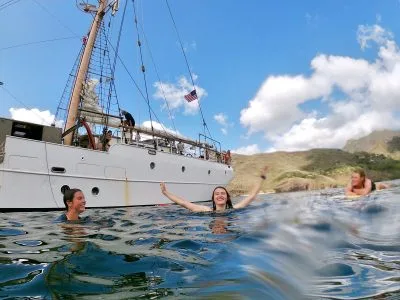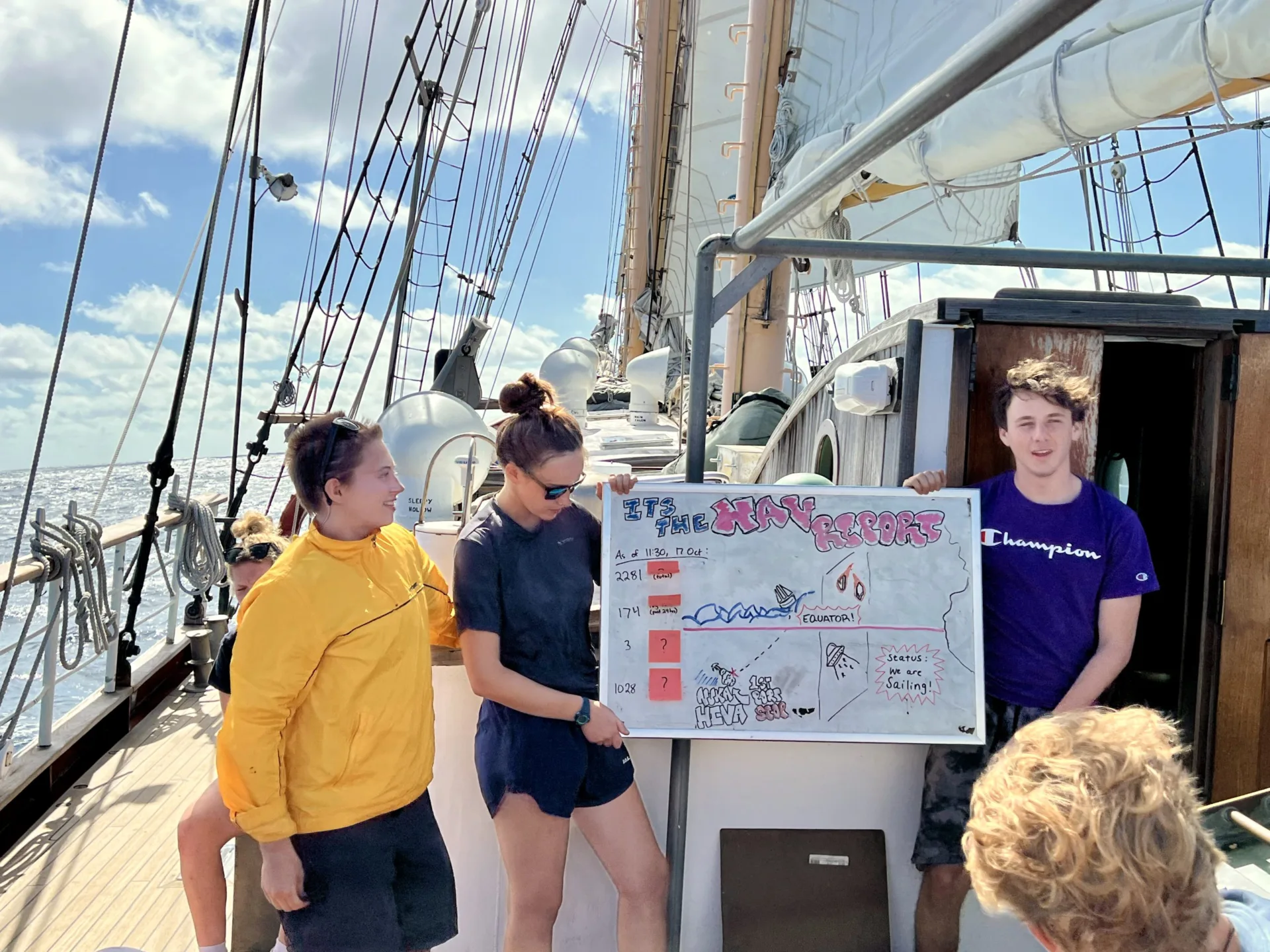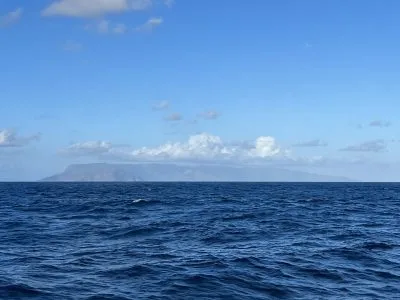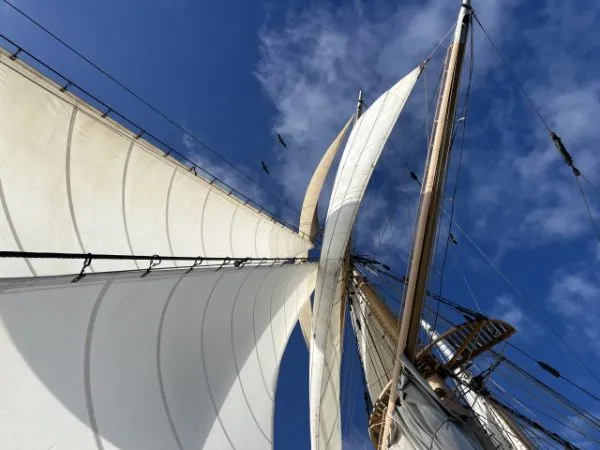News
Episode 4: Land Looked Like a Low Cloud





Welcome back to Stories at SEA! As with last week, the fourth week brought about much excitement onboard as we neared land, specifically the Marquesas Islands of Hiva Oa and Tahuata. Seeing land for the first time after so many days at sea produced a mixed bag of emotions onboard: relief, awe, bewilderment, but I think it was safe to say the dominant one was excitement. Even though we knew we wouldn’t be going ashore quite yet, reaching French Polynesia was a proud moment for everyone. We’d all worked so hard to get there.
As for daily life onboard, we hear from Katie Power, Keeghan Ryan, Parker Rehmus, and Diego Fernandez about what the second and third phases of watch standing were like. Parker brought up the fact that he likes to be confident in his skills before becoming a leader, but that wasn’t always the case in this third phase. We were all Junior Watch Officers (JWOs) or Junior Lab Officers (JLOs) at some point even when we had uncertainties about lab procedures or sail handling techniques. The point was to continue to learn and grow as a team. Diego also shared an important piece of wisdom, passed onto him from our Captain Kevin “Kevo” Murray, which is that you get out of an experience what you put in. At the end of the day (even if that was at 1 am), it was important to be able to look back and say “I tried my best, I worked hard, and I learned a lot.” This third phase of our sail education was stressful and certainly pushed me out of my comfort zone, but I always knew that I could rely on my watch.
Reaching the Marquesas Islands also meant that student projects started wrapping up. There was a lot of work in those final days leading up to student presentations on November 1. More lab time was devoted to working on projects and the main salon was often full of students with laptops putting together their projects. Katie Power speaks for her group (she was working with Rikki Held and Stella Steufert) about the impact of mixed layer depth on primary production. A possible metaphor for mixed layer depth is the action of diving for pool toys in the pool. Their initial hypothesis didn’t end up fitting with their data, and I highlight that just to say that that is a key part of conducting scientific research. We form hypotheses that best fit our understanding of an environment, but very often those ideas are proved wrong and as Katie’s group did, we have to return to the body of literature (in our case textbooks since we couldn’t access online papers) to interpret our results. The world is this marvelously complicated place that the scientific method is simply trying to study.
We also hear from Micah Strike who studied myctophids and their abundance relative to zooplankton and phytoplankton biodiversity. They used lots of data from neuston net tows which we’ll learn more about in the next episode when we feature the neuston and meter nets. At the time I interviewed Micah, they were finding that in areas with high phytoplankton levels there was also high zooplankton abundance but myctophid numbers didn’t correspond with those trends. That was strange, because Micah thought that in places with lots of food for myctophids, there would be lots of myctophids. Every student project, but also research in general, generated lots of questions that have the potential to fuel future research. You never know, maybe a topic here will spark an idea of your own!
I never knew what kind of story people were going to tell when I asked about a memory of the ocean. As it turned out, several people told stories about being on an island. We heard from Katie Power talking about Sanibel Island on the west coast of Florida, Dr. Vero Carignan one of the chief scientists talking about Magdalen Island in Quebec, Craig Marin one of the faculty onboard reminiscing about sailing to the Bahamas as a teenager, Micah Strike studying octopuses on Turks and Caicos, Brighton Hedger talks about snorkeling with sea turtles, and Keeghan Ryan tells one of my favorite stories about night diving with manta rays in Hawaii. People have such remarkable stories and I feel really lucky to have heard them and to be able to share them with you all.
The last section I want to include before I sign off this blog post is a profile of ship noises. If you’ve been listening closely (or sometimes you don’t even need to have been listening closely at all) you’ll have heard a whole range of bangs, clangs, and bells. This week, we heard someone ringing the galley triangle for lunch time during Parker Rehmus’s segment about class. A few minutes before every meal someone would walk around the entire ship announcing the meal and who’s turn it was to eat, meaning which watch was scheduled to eat at that time (don’t worry, everyone gets to eat every meal just in two different seatings). The sound of the clock chiming in the chart room just above the aft cabin can be heard in almost every interview, and there have been numerous crashes as things have slid off of the table during an interview. Aside from those sounds, I hope you’re able to catch snippets of people laughing, cheering, and even singing. The boat could be a noisy place, and it was a joyful thing to be able to capture some of that sound.
This is where I’ll leave off for this fourth week aboard the Robert C. Seamans. The fourth week was a momentous time for all of us as it represented a huge milestone in our trip: getting to land after a long open water passage. Next week, we’ll hear about snorkeling off of Rangiroa, class presentations off of Papeete, Tahiti, and our arrival at Raiatea – a real whirlwind of island hopping. As always thanks for listening and fair winds! Many thanks to Paloma Cestar, Emily Rogers, Aster Van Dyke, Olivia Chiota, Katie Power, Parker Rehmus, Keeghan Ryan, Diego Fernandez, Micah Strike, Brighton Hedger, Dr. Vero Carignan, and Dr. Craig Marin for sitting down to chat with me for this episode, to the entire crew of the Robert C. Seamans for letting me take time each day to interview in the aft cabin, and to Dr. Sarah Kingston for her photograph that was the inspiration for the podcast cover art.